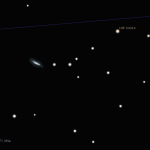| Meaning: | The Great Bear | Print out the star map from Free Star Charts
Things to look for: Messier objects: Note: [x.x] indicates visual magnitude |
|
| Pronunciation: | er’ suh may’ jor | ||
| Associated Asterisms: | The Big Dipper, The Plough, The Saucepan | ||
| % of the sky: | 3.1% | ||
| Visible Stars: | 71 stars brighter than magnitude 5.5 |


This big constellation is much larger than just the familiar asterism of the Plough. The Plough is simply the tail and rump of the Bear.
From the UK, it will be visible upon every clear night sky. This is because of its proximity to Polaris, the North Star and the latitude of the UK. If you could see through the bright daytime sky, you’d notice it was always visible. It is a circumpolar constellation.
Finding it is simply a matter of knowing the general direction of North. If you look to the North, you’ll most probably see the 7 bright stars of the Plough Asterism without any further assistance. The inset picture shows Ursa Major’s position throughout the year at 9pm UTC each evening. In April, Ursa Major is pretty much overhead. In July, it is NorthWest. In October, it is due North. Finally in January, it is North East.
Getting the hang of locating Ursa Major is key as it is a gateway constellation in northern hemisphere; once you find it, finding other constellations quickly follows. Imagine a line from the two stars opposite the handle of the Plough asterism, Merak to Dubhe. Extend this imaginary line upward 5 lengths and you’ll reach Polaris, the North Star. For me, Cassiopeia and Orion also give an immediate recognition of the orientation of the sky at that moment in time.


The 7 named stars of the Saucepan/Plough from the handle are: Alkaid, Mizar, Alioth, Megres, Phecda, Merak, Dubhe. Stars in constellations receive a greek letter designation based on descending brightness from alpha α, beta β, gamma γ, delta δ etc on. Of interest, for Ursa Major they are out of sequence with the brightest to least being Alioth(epsilon ε), Dubhe(alpha α), Alkaid(eta η), Mizar(zeta ζ), Merak(beta β), Phecda(gamma γ); Megrez(delta δ) is a whole magnitude dimmer than Phecda.
Mizar, the bump on the handle, has a visual companion called Alcor. You should be able to make this out without optical aide. They are often called the horse and rider. Mizar is also an actual double star rather than just line of sight with Alcor. The primary star of this double is also double but this can’t be split without use of a spectroscope. Similarly, Alcor is also a spectroscopic double.
A good resource for further information on Ursa Major is the website https://freestarcharts.com
Finding the Messier objects
| Object | Location | Detail | Visual Magnitude | Description |
|---|---|---|---|---|
| M81 and M82 | M81 6.94
M82 8.41 |
M81 is called Bode’s Galaxy or Bode’s Nebula. It is a spiral galaxy about 11.8 million light years away. It is 26′ by 14′. Read more on Wikipedia
Nearby M82 is called the Cigar Galaxy and is visually smaller than M82 as it 11′ by 4′. The galaxy was once described as an irregular galaxy but is now referred to as a starburst galaxy – probably caused by the proximity of M81. It is 12 million light years away. Read more on Wikipedia |
||
| M97 | 9.9 | M97 is called the Owl Nebula and is a planetary nebula. It is 2000 light years away and the expanding nebula is 0.9 light years across. Visually, it is 3′ by 3′. It is found not far from the star Merak. Find the star and come back one fifth of the way to Phecda. Drop down slightly. You may see M108 just over half way from Merak to M97. Read more on Wikipedia | ||
| M101 | 7.86 | M101 is called the Pinwheel Galaxy and is a superb example of a side on spiral galaxy. It is 21 million light years away and visually appears 29′ by 27′. Find the 3rd star in the handle, Alioth. Draw an imaginary line to Mizar and then extend the line the same distance again beyond Mizar. Read more on Wikipedia | ||
| M108 | 10.70 | M108 or the Surfboard Galaxy is 46 million light years distant and is a barred spiral galaxy. It is found between the star Merak and M97 Owl Nebula. Edge on, it is visually only 8′ by 2′. Read more on Wikipedia | ||
| M109 | 10.60 | M109 or the Vacuum Cleaner Galaxy is a short pan to the left from Phecda. It is a barred spiral about 7′ by 4′. It is 80 million light years distant. Read more on Wikipedia |







